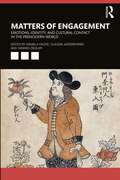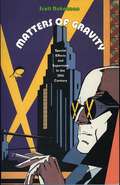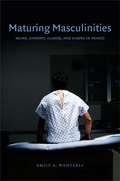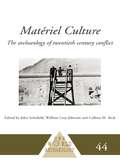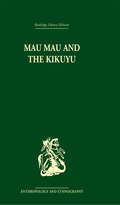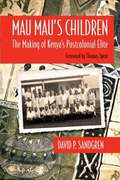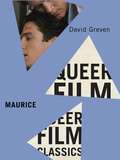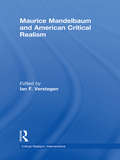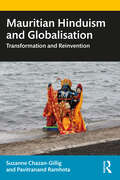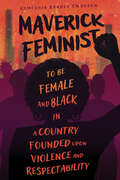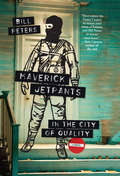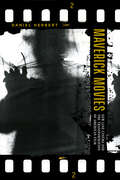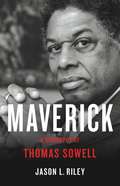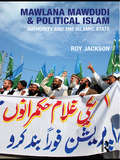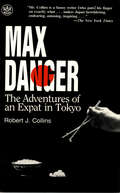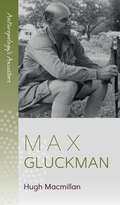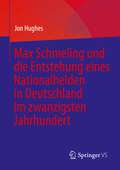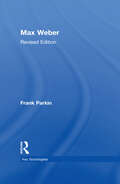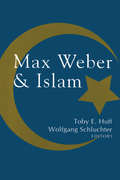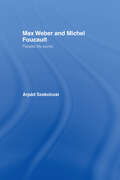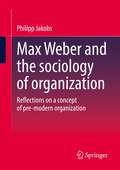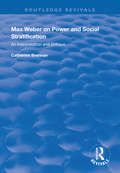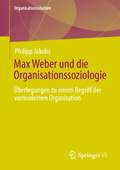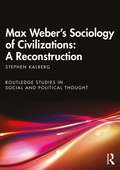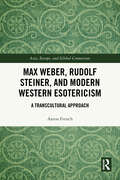- Table View
- List View
Matters of Engagement: Emotions, Identity, and Cultural Contact in the Premodern World
by Daniela Hacke; Claudia Jarzebowski; and Hannes ZieglerBy drawing on a broad range of disciplinary and cross-disciplinary expertise, this study addresses the history of emotions in relation to cross-cultural movement, exchange, contact, and changing connections in the later medieval and early modern periods. All essays in this volume focus on the performance and negotiation of identity in situations of cultural contact, with particular emphasis on emotional practices. They cover a wide range of thematic and disciplinary areas and are organized around the primary sources on which they are based. The edited volume brings together two major areas in contemporary humanities: the study of how emotions were understood, expressed, and performed in shaping premodern transcultural relations, and the study of premodern cultural movements, contacts, exchanges, and understandings as emotionally charged encounters. In discussing these hitherto separated historiographies together, this study sheds new light on the role of emotions within Europe and amongst non-Europeans and Europeans between 1100 and 1800. The discussion of emotions in a wide range of sources including letters, images, material culture, travel writing, and literary accounts makes Matters of Engagement an invaluable source for both scholars and students concerned with the history of premodern emotions.
Matters of Gravity: Special Effects and Supermen in the 20th Century
by Scott BukatmanThe headlong rush, the rapid montage, the soaring superhero, the plunging roller coaster--Matters of Gravity focuses on the experience of technological spectacle in American popular culture over the past century. In these essays, leading media and cultural theorist Scott Bukatman reveals how popular culture tames the threats posed by technology and urban modernity by immersing people in delirious kinetic environments like those traversed by Plastic Man, Superman, and the careening astronauts of 2001: A Space Odyssey and The Right Stuff. He argues that as advanced technologies have proliferated, popular culture has turned the attendant fear of instability into the thrill of topsy-turvydom, often by presenting images and experiences of weightless escape from controlled space. Considering theme parks, cyberspace, cinematic special effects, superhero comics, and musical films, Matters of Gravity highlights phenomena that make technology spectacular, permit unfettered flights of fantasy, and free us momentarily from the weight of gravity and history, of past and present. Bukatman delves into the dynamic ways pop culture imagines that apotheosis of modernity: the urban metropolis. He points to two genres, musical films and superhero comics, that turn the city into a unique site of transformative power. Leaping in single bounds from lively descriptions to sharp theoretical insights, Matters of Gravity is a deft, exhilarating celebration of the liberatory effects of popular culture.
Maturing Masculinities: Aging, Chronic Illness, and Viagra in Mexico
by Wentzell Emily A.Maturing Masculinities is a nuanced exploration of how older men in urban Mexico incorporate aging, chronic illness, changing social relationships, and decreasing erectile function into their conceptions of themselves as men. It is based on interviews that Emily A. Wentzell conducted with more than 250 male patients in the urology clinic of a government-run hospital in Cuernavaca. Drawing on science studies, medical anthropology, and gender theory, Wentzell suggests the idea of "composite masculinities" as a paradigm for understanding how men incorporate physical and social change into gendered selfhoods. Erectile dysfunction treatments like Viagra are popular in Mexico, where stereotypes of men as sex-obsessed "machos" persist. However, most of the men Wentzell interviewed saw erectile difficulty as a chance to demonstrate difference from this stereotype. Rather than using drugs to continue youthful sex lives, many collaborated with wives and physicians to frame erectile difficulty as a prompt to embody age-appropriate, mature masculinities.
Matériel Culture: The Archaeology of Twentieth-Century Conflict (One World Archaeology)
by John Schofield William Gray Johnson Colleen M. BeckMatériel culture encompasses the material remains of conflict, from buildings and monuments to artefacts and militia, as well as human remains. This collection of essays, from an international range of contributors, illustrates the diversity in this material record, highlights the difficulties and challenges in preserving, presenting and interpreting it, and above all demonstrates the significant role matériel culture can play in contemporary society. Among the many studies are: * the 'culture of shells' * the archaeology of nuclear testing grounds * Cambodia's 'killing fields' * the Berlin Wall * and the biography of a medal *the reappearance of Argentina's 'disappeared' *World War II concentration camps.
Mau Mau and the Kikuyu
by Louis LeakeyThis widely-acclaimed book on a troubled period of Kenyan history summarizes some of the more important Kikuyu customs, and a discussion of their break-down under the impact of European civilization. This discussion illustrates why and how the Mau Mau came into being and how the situation could be improved so that peace could once again come to Kenya.
Mau Mau's Children
by David P. SandgrenIn 1963 David P. Sandgren went to Kenya to teach in a small, rural school for boys, where he remained for the next four years. These were heady times for Kenyans, as the nation gained its independence, approved a new constitution, and held its first elections. In the school where Sandgren taught, the sons of Gikuyu farmers rose to the challenges of this post colonial era and, in time, entered Kenyan society as adults, joining Kenya’s first generation of post colonial elites. InMau Mau’s Children, Sandgren has reconnects with these former students. Drawing on more than one hundred interviews, he provides readers with a collective biography of the lives of Kenya’s first postcolonial elite, stretching from their 1940s childhood to the peak of their careers in the 1990s. Through these interviews,Mau Mau’s Childrenshows the trauma of growing up during the Mau Mau Rebellion, the nature of nationalism in Kenya, the new generational conflicts arising, and the significance of education and Gikuyu ethnicity on his students' path to success.
Maurice (Queer Film Classics #8)
by David GrevenMaurice, James Ivory’s 1987 adaptation of the E.M. Forster novel, follows an Edwardian man’s journey from the awakening of his desire for and love of men to self-acceptance. One of the most politically resistant films of the 1980s, Maurice dared to depict a young man’s coming-out story and a happy ending for its lovers, Maurice and Alec.James Ivory and producer Ismail Merchant, a couple whose cinema is synonymous with period film adaptation, released Maurice during the first AIDS decade, a time of flagrant transatlantic homophobia. Criticism following its release described Ivory as a superficial and staid director, while the film was received as a regression to the uncinematic and overly faithful style that characterized the early adaptations by Merchant Ivory Productions. Offering a close reading of Forster’s novel and an analysis of Ivory’s distinctive visual style, Richard Robbins’s indelible score, and the performances of James Wilby, Hugh Grant, and Rupert Graves, David Greven argues that the film is a model of sympathetic adaptation. This study champions the film as the finest of the Merchant Ivory works, making a case for Ivory’s underappreciated talents as a director of great subtlety and intelligence, and for the film as one worth recuperating from its detractors.Understanding Maurice as a fully realized work of art and adaptation, this volume offers insight into how a stunning novel of gay love became a classic of queer film.
Maurice Mandelbaum and American Critical Realism
by Ian F. VerstegenMany have wondered about the similarity in name of American critical realism and the movement of the same name begun by Roy Bhaskar. The figure of Maurice Mandelbaum complicates the relationship, not only due to his career bridging the two movements but also Mandelbaum’s concern not only with traditional concerns of American critical realism (epistemology and philosophy of science) but the nature of society, the nature of social explanation, and naturalism. This volume reflects both on Mandelbaum’s own career and the relation of his thought to Bhaskar’s critical realism. By examining Mandelbaum’s commitments to phenomenology within critical realism, as well as his goal to enlighten social scientific and above all historiographical categories, it is possible to see how Mandelbaum went beyond the scientific realism of his predecessors. At the same time, a fruitful comparison with Bhaskar’s and others’ thought is undertaken by examining mandelbaum’s solutions to the problems of the ontology of sociology and social laws, the dynamics of cultural change and the overriding master narratives that govern late capitalism. By explaining Mandelbaum’s scrupulous attempt to address the horrors of the twentieth century, it is possible to appreciate his significance for the twenty-first. A timely and important book, Maurice Mandelbaum and American Critical Realism is essential reading for all serious students of critical realism and twentieth century philosophy.
Mauritian Hinduism and Globalisation: Transformation and Reinvention
by Suzanne Chazan-Gillig Pavitranand RamhotaThis book presents an original and comprehensive overview of the transformation of Mauritian Hinduism against the backdrop of globalisation. It discusses themes such as the cult of Baharia Puja; the cult of “Camp De Masque”; changes in popular cults; temples and associative strategies of social integration; emergence of Hanuman; ritual innovations in politics and, religious and political transformation due to globalisation to highlight the link between the reinvention of Hinduism and Mauritian capitalism. The first of its kind, this book with its rich ethnographic accounts, will be an essential read for scholars and researchers of religion, Hinduism, social anthropology, sociology, cultural studies, diaspora studies, sociology of religion and African studies.
Maverick Feminist: To Be Female and Black in a Country Founded upon Violence and Respectability
by Kemeshia Randle SwansonBeginning with their forced introduction to American soil, Black women have relied on maverick-like characteristics to survive. And yet, these liberating qualities have been repeatedly disparaged by the masses in favor of an elitist politics of respectability. In Maverick Feminist: To Be Female and Black in a Country Founded upon Violence and Respectability, scholar Kemeshia Randle Swanson examines the extent to which the politics of respectability diminish joy and increase sorrow throughout the lifespan of Black women. By rejecting this damaging standard in society, Black women can wholly and attentively assist in the obliteration of racist, sexist, classist, and ableist oppression. But first, they must work towards becoming self-identified, self-actualized, and self-sexualized.Bridging the gap between women in both the streets and the academy, Maverick Feminist expands the traditional understandings of activism and enlarges discussions about Black female sexuality. Swanson emphasizes sexuality’s significance to the literary and sociopolitical success of Black women of the past and in this contemporary climate. Through close readings and critical analyses of fiction, nonfiction, and popular culture, Swanson argues that #BlackGirlMagic and racial progression require rejecting respectability politics and developing an intimate appreciation of self. Maverick Feminist examines texts by and about bold Black women, including Zora Neale Hurston’s Their Eyes Were Watching God, Sister Souljah’s The Coldest Winter Ever, Brittney Cooper’s Eloquent Rage: A Black Feminist Discovers Her Superpower, Alice Walker’s The Color Purple, Sapphire’s PUSH, Roxane Gay’s Hunger: A Memoir of (My) Body, Terry McMillan’s Getting to Happy, and Michelle Obama’s Becoming.Maverick Feminist offers hope concerning the growing divide between scholars and the communities about which they theorize. The book celebrates centuries of agency and control that Black women have mustered and maintained in a world that seems to want nothing more than to see them prone and powerless. Ultimately, maverick feminism provides a freer means of living out, evaluating, understanding, and improving the lives of Black women.
Maverick Jetpants in The City of Quality: A Novel
by Bill Peters". . . Bill Peters belongs in the ranks of serious literary artists."-New York Times Book Review, Editor's Choice"By turns funny and moving, this debut richly captures life in a decaying American city."-Publishers Weekly"A complex and inventive debut, innovative with language and delightfully unique."-Largehearted Boy"Maverick Jetpants in the City of Quality is Peters' energetic novelistic response to . . . the universal passage from adolescence to adulthood, the impermanence of friendship and familiar landscapes. . . Readers looking for a story about the slippery transition from silliness to sincerity will find in Maverick Jetpants a style to savor and get lost in."-HTML Giant"There were times, while reading Maverick Jetpants, I thought: This isn't a book. It's a panic attack. In a good way. In the way where everything about it is frantic and urgent."-Necessary Fiction"Peters has done something just this side of insane with this book; he's created a character that speaks in a voice everyone will recognize, even while half the words he says allude to things none of us were part of."-Bookslut"Peters proves himself adept at wordplay through the wildly inventive language of the characters."-The Coffin Factory"One of the most inventive novels published this year."-The Los Angeles Review"Maverick Jetpants in the City of Quality announces the arrival of a powerful and innovative young voice in American fiction."-Literate Man"They aren't necessarily found in a prime spot in every writer's toolbox, but fictional private languages can be evocatively effective when used well. Bill Peters's novel Maverick Jetpants in the City of Quality is one example of this."-Vol. 1 Brooklyn"With all the elements of the best coming-of-age novels, Maverick offers a voice and a story that could connect with someone of just about any age, as long as they have the appreciation for nimble, far out, and witty repartee."-ForeWord Reviews"Full of madcap energy, swagger, and brinksmanship."-Fiona Maazel, author of Last, Last Chance"Do you want laughter, suffering, and friendship, Rochester-style? Do you want to marinate in raucous sadness? I know you do. So be ready, everybody. Here comes the Vomit Cruiser to rescue your sense of humor, and Bill Peters to rescue your heart."-Sam Lipsyte, author of Homeland and Venus DriveRochester, New York, 1999: An arsonist is loose on the streets of a city in decline. Gone are the days of Rioting in the Vomit Cruiser, searching for a possible Tokyo Rocking Horse. In this hilarious, wildly original debut novel, Nathan Gray and best friend Necro live by the code of Joke Royalty, a system of in-jokes known only to a select few. But as the reality of full-time employment, possible spouses, and Neo-Nazis encroaches, their friendship unravels, threatening their dreams of becoming Kodak Park Winjas.Among the gravest Hellstacheries: Necro's strangely vicious drawings and his sudden interest in a group of weapons enthusiasts who may or may not be responsible for the fires erupting through downtown. With no Holy Grail Points left to his name, Nate ventures into Rochester's strangest corners to find out if his best friend is a domestic terrorist Pinning Bow Ties on the Dead or simply Maverick Jetpantsing on with his life-perhaps even beyond The City of Quality.Bill Peters grew up in Rochester, New York, and has received fiction fellowships from the Massachusetts Cultural Council and the University of Massachusetts. He works as a copy editor for the New York Times News Service, the wire service for the New York Times, and lives in Gainesville, Florida. This is his first novel.
Maverick Movies: New Line Cinema and the Transformation of American Film
by Daniel HerbertA free ebook version of this title is available through Luminos, University of California Press’s Open Access publishing program. Visit www.luminosoa.org to learn more.Maverick Movies tells the improbable story of New Line Cinema, a company that cut a remarkable path through the American film industry and movie culture. Founded in 1967 as an art film distributor, New Line made a small fortune running John Waters's Pink Flamingos at midnight screenings in the 1970s and found reliable returns with the Nightmare on Elm Street franchise in the 1980s. By 2001, the company competed with the major Hollywood studios and reached global box office success with the Lord of the Rings franchise. Blurring boundaries between high and low culture, between independent film and Hollywood, and between the margins and the mainstream, New Line Cinema epitomizes Hollywood's shift in focus from the mass audience fostered by the classic studios to the multitude of niche audiences sought today.
Maverick: A Biography of Thomas Sowell
by Jason L RileyA biography of Thomas Sowell, one of America's most influential conservative thinkers.Thomas Sowell is one of the great social theorists of our age. In a career spanning more than a half century, he has written over thirty books, covering topics from economic history and social inequality to political theory, race, and culture. His bold and unsentimental assaults on liberal orthodoxy have endeared him to many readers but have also enraged fellow intellectuals, the civil-rights establishment, and much of the mainstream media. The result has been a lack of acknowledgment of his scholarship among critics who prioritize political correctness.In the first-ever biography of Sowell, Jason L. Riley gives this iconic thinker his due and responds to the detractors. Maverick showcases Sowell's most significant writings and traces the life events that shaped his ideas and resulted in a Black orphan from the Jim Crow South becoming one of our foremost public intellectuals.
Mawlana Mawdudi and Political Islam: Authority and the Islamic state
by Roy JacksonMawlana Mawdudi was one of the most influential and important Islamic thinkers of the modern world, whose brand of political Islam has won widespread acceptance in South and South East Asia as well as the Middle East. He was not only an Islamic scholar, but also a journalist and political activist who founded the Jama’at-i-Islami, which has subsequently influenced the development of many Islamic movements and parties throughout the Muslim world. This book is the first to critically engage and assess his career and legacy within the wider context of political Islam. It includes coverage of his early life and influences, and examines his considerable influence in the contemporary Islamic world. The issues that were a concern for Mawdudi and continue to have resonance for our world today include such questions as the role of women in Islam, the possibilities for democracy in an Islamic state, the importance of jihad, and the moral and religious responsibility of the individual. Whilst focus is on Mawdudi’s life and writings, this is placed within the wider context of topical, often contentious, Islamic thought. Providing an up-to-date and detailed critical study of Mawlana Mawdudi and many issues surrounding political Islam both in his time and today, this book will be an important text for scholars of Islamic Studies, Political Science and Philosophy.
Max Danger
by Robert J. CollinsFollow the adventures of Tokyo's favorite expatriate Max Danger, as he weaves his way in and out of the intricacies and dilemmas of living in Japan from baffling bilingual breakfast meetings, through the mind-boggling enigmas of doing business in Japan, to the dubious pleasures of late-night hostess clubs. Max Danger seems to exhaust himself just trying to make it through the day.
Max Gluckman (Anthropology's Ancestors #6)
by Hugh MacmillanThis handy, concise biography describes the life and intellectual contribution of Max Gluckman (1911-75) who was one the most significant social anthropologists of the twentieth century. Max Gluckman was the founder in the 1950s of the Manchester School of Social Anthropology. He did fieldwork among the Zulu of South Africa in the 1930s and the Lozi of Northern Rhodesia/Zambia in the 1940s. This book describes in detail his academic career and the lasting influence of his Analysis of A Social Situation in Modern Zululand (1940-42) and of his two large monographs on the legal system of the Lozi. From the Introduction: Max Gluckman was the most influential of a group of social anthropologists who emerged from South Africa during the 1930s into what was essentially a new academic discipline. His description and analysis of events in real time implied a rejection of contemporary social anthropological practice, of the ‘ethnographic present’, and of hypothetical or conjectural reconstructions and an acceptance of the need to study ‘primitive’ societies in the context of the modern world.
Max Schmeling und die Entstehung eines Nationalhelden in Deutschland im zwanzigsten Jahrhundert
by Jon HughesDieses Buch ist die erste umfassende Studie über den deutschen Boxer Max Schmeling (1905-2005) als Nationalheld und Repräsentationsfigur in Deutschland zwischen den 1920er Jahren und der Gegenwart. Es untersucht die komplexen Beziehungen zwischen Sport, Kultur, Politik und nationaler Identität und stützt sich dabei auf ein Jahrhundert von Journalismus, Film, bildender Kunst, Lebensberichten und Belletristik. Detaillierte Kapitel analysieren Schmelings Aufstieg zur Ikone in der Weimarer Republik, seine Verbindung zu Amerika, seinen Prominentenstatus im Dritten Reich und seine Rivalität mit Joe Louis als Mittelpunkt eines außergewöhnlichen propagandistischen und ideologischen Wettstreits. Das Buch untersucht auch, wie Schmelings geschäftlicher Erfolg in der Nachkriegszeit ihn mit der Kultur der "Stunde Null" in der Ära des "Wirtschaftswunders" in Verbindung brachte und wie er später als "guter Deutscher" und moralisches Beispiel für eine Nachkriegsgeneration von Deutschen, die entschlossen waren, die Vergangenheit zu "bewältigen", in Anspruch genommen wurde. Das Buch richtet sich an Leser, die sich für die Geschichte des Sports und des Boxens, für Sportdiskurse und politische Kultur sowie für Fragen der nationalen Identität in der modernen deutschen Geschichte interessieren.
Max Weber (Key Sociologists Ser.)
by Frank ParkinThis study of Weber's sociology, written by an eminent authority, is a clear and illuminating discussion of the most important elements of Weber's thinking. The book concentrates on four main elements of Weber's work: his approach to sociological method, ethical neutrality and historical explanation; his influential work on religion and capitalism; his theory of authority and political power; and his contribution to the analysis of class, status and party.
Max Weber and Islam
by Wolfgang SchluchterMax Weber and Islam is a major effort by Islamic-studies specialists to reexamine and appraise Max Weber's perspectives on Islam and its historical development. Eight specialists on Islam and two sociologists explore many dimensions of Weber's comments on Islam, along with Weber's conceptual framework. The volume's introduction links the discussions to contemporary issues and debates.Wolfgang Schluchter reconstructs Weber's conceptual apparatus as it applies to Islam and its historical development. In subsequent chapters, Islamic specialists consider such major topics as the developmental history of Islam, Islamic fundamentalism, Islamic reform, Islamic law and capitalism, secularization in Islam, as well as the value of attempting to apply Weber's concept of sects to Islam. While some authors find flaws in Weber's factual knowledge of Islam, they also find considerable merit in the kinds of questions Weber raised.Contributors to the volume include highly respected contemporary international scholars of Islam: Ira Lapidus, Nehemia Levtzion, Richard M. Eaton, Peter Hardy, Rudolph Peters, Barbara Metcalf, Francis Robinson, Patricia Crone, Michael Cook, and S.N. Eisenstadt. Toby Huff's introduction not only knits the thematics of the separate essays together but adds its own stresses while engaging the contributors in dialogue and debate about fundamental issues. This acute collective analysis establishes a new benchmark for understanding Weber and Islam. This book also provides an up-to-date overview of the developmental history of many aspects of Islam. A major reappraisal of the entire span of Max Weber's sociological thought on Islam, this book will appeal to a wide range of scholars and laymen interested in the Islamic world. It will be of particular interest to sociologists specializing in religion and Middle East area specialists.
Max Weber and Michel Foucault: Parallel Life-Works (Routledge Studies in Social and Political Thought)
by Arpad SzakolczaiMax Weber and Michael Foucault are among the most controversial and fascinating thinkers of our century. This book is the first to jointly analyse them in detail, and to make effective links between their lives and work; it coincides with a substantial resurgence of interest in their writings. The author's exciting interpretative approach reveals a new dimension in reading the work of Foucault and Weber; it will be invaluable to students and those researching in sociology and philosophy.
Max Weber and the sociology of organization: Reflections on a concept of pre-modern organization
by Philipp JakobsIn today's organizational sociology, organizations are usually regarded as late achievements of modernity in the history of mankind. Max Weber is repeatedly cited as the supposed guarantor of this thesis. But neither his type of "bureaucratic rule" nor his concept of "rational work organization" - although both are tailored to modern conditions - contain, on closer inspection, compelling arguments for a principled limitation of organizations as such to modernity. Both actually reach their depth of focus only in contrast to "pre-modern" forms of organization. A sociology of organization that wants to refer to Max Weber's work while avoiding the numerous common misunderstandings of its reception must broaden its historical view and consider the possibility of "pre-modern organizations".
Max Weber on Power and Social Stratification: An Interpretation and Critique (Routledge Revivals)
by Catherine BrennanFirst published in 1997, this book revolves around a textual analysis of the Weberian thesis that 'classes', 'status groups' and 'parties’ are phenomena of the distribution of power within a 'community'. An internal reconstruction of Weber’s own ideas on what is called social stratification in contemporary sociological discourse is undertaken. The reason for this reconstruction inheres in the fact that Weber’s thought (especially in the field of social stratification) has been modified and misappropriated to such an extent that Weber himself is usually lost in the commentaries. Moreover, this reconstruction is crucial because the secondary literature does not contain a single account teasing out the analytic structure underlying Weber’s statements on the nature of social inequality in various societies. It is the principal intention of the book, then, to retrieve the essential form and significance of Weber’s ideas on social stratification.
Max Weber und die Organisationssoziologie: Überlegungen zu einem Begriff der vormodernen Organisation (Organisationsstudien)
by Philipp JakobsOrganisationen gelten in der heutigen Organisationssoziologie meist als menschheitsgeschichtlich späte Errungenschaften der Moderne. Als vermeintlicher Gewährsmann dieser These wird immer wieder Max Weber angeführt. Doch weder dessen Typus „bürokratischer Herrschaft“ noch dessen Begriff der „rationalen Arbeitsorganisation“ – obgleich beide auf moderne Verhältnisse zugeschnitten sind – enthalten bei näherem Hinsehen zwingende Argumente für eine prinzipielle Begrenzung von Organisationen als solchen auf Moderne. Beide erreichen eigentlich erst im Kontrast zu „vormodernen“ Organisationsformen ihre Tiefenschärfe. Eine Organisationssoziologie, die sich unter Vermeidung der zahlreichen gängigen Missverständnisse der Rezeption auf Max Webers Werk berufen will, muss ihren historischen Blick weiten und die Möglichkeit „vormoderner Organisationen“ in Betracht ziehen.
Max Weber's Sociology of Civilizations: A Reconstruction (Routledge Studies in Social and Political Thought)
by Stephen KalbergThis volume examines civilizations through the broad lens articulated by the works of Max Weber. In focusing upon his comparative-historical mode of analysis and his causal explanations for the sources, contours, and trajectories of civilizations, this study reconstructs Weber’s sociology in a manner that provides clear guidelines to researchers seeking to investigate civilizations systematically. Through detailed interpretations of the West’s unique development from Antiquity to the Modern era, precise comparisons to the long-range and singular pathways taken by China and India, and careful demarcations of the "particular rationalisms" of several civilizations, the author addresses Weber’s powerful model-building on the one hand and his opposition to organic holism and structural presuppositions on the other hand. Both a broad-ranging conceptual framework and case-based empirical investigations are pivotal to Weber. His research strategy emphasizes further the "subjective meanings" of actors East and West and the deep cultural origins of groups. Finally, this volume masterfully conveys Weber’s contextual and multi-causal methodology rooted in a tight interweaving of the present with the past. Max Weber’s Sociology of Civilizations: A Reconstruction will appeal to comparative sociologists and historians, as well as to theorists of all persuasions. The social scientist pursuing a cross-civilizational agenda will here discover the distinct contribution of Weber’s "interpretive understanding" procedures to the now-essential field of civilizational analysis.
Max Weber, Rudolf Steiner, and Modern Western Esotericism: A Transcultural Approach (Asia, Europe, and Global Connections)
by Aaron FrenchThis book challenges previous definitions of modernity by comparing Max Weber (1864–1920), often considered the most important sociologist of the 20th century, and Rudolf Steiner (1861–1925), founder of Waldorfpädagogik and the esoteric social reform movement of anthroposophy.While acknowledging that Weber and Steiner were different in several respects, this research illustrates that the individual histories of these two thinkers are more entangled than previously recognized. This includes the influence of esotericism on their thinking, as well as their profound concern with science and technological change and an openness to the religious and philosophical concepts of the civilizations of South and East Asia.Demonstrating the importance of non-European influences for a full understanding of modernity, this book will be a valuable resource for students and scholars of Asian and European philosophy, social theory, and Asian society.
